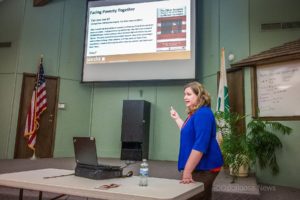What Does Poverty Look Like In Mahaska County

Natalie Aeschliman, Community Outreach and Data Specialist for SIEDA, talks about how poverty in Mahaska County may not be noticed.
Oskaloosa, Iowa – Community members gathered at the ISU Extension building on Monday to talk about poverty in Mahaska County, and what does that look like.
Natalie Aeschliman, Community Outreach and Data Specialist for SIEDA, said that during her work with low-income individuals, poverty can almost be invisible, and poverty has many different definitions from many different organizations that help those in poverty.
“Even in our own government or programs that work with low income, they don’t even have a defined poverty line. There’s a lot of different levels that they will show numbers on, whether it’s 100% or 150%,” added Aeschliman. An example being that heating assistance kicks in at 175% of the federal poverty level.
Aeschliman encouraged those in attendance to come up with better words to describe poverty.
Poverty- Not having the necessary resources for daily living, which include shelter, food, and safety. Poverty can also be generational, according to those participating in the discussion.
Work by Michael Harrington, exploring poverty in America during the 1960’s, was used for historical context to the discussion, in which he helped to coin the phrase “culture of poverty,” and believed that an “assault on poverty” was the best way to bring the poor up in America.
In Mahaska County, its 185% of the federal poverty level used by SEIDA for heating assistance is at 32.7%, which is an increase from the 30.5% seen in 2010. Aeschliman said that “almost a third of the population of Mahaska County is struggling on a daily basis with getting bills paid, and worries about not being able to meet a bill and losing their utilities or losing their home.”
In Mahaska County, according to the 2016 data, nearly 6.6% of the population lives below the 50% federal poverty level, which is extreme poverty level.
The federal poverty line for a single person is $12,140 a year, while a family of 4 is $25,100.
In Mahaska County, 16.1% of the population under the age of 18 live below the federal poverty level, compared to the state of Iowa which is 15.3%.
The population overall is at 12.3% in Iowa that live below the federal poverty level, but that rate is higher in Mahaska County with a total of 13.9% below the federal poverty level.
Those at the federal poverty level are often faced, on a daily basis, with where they will get their food, where they will get clothing, and paying utilities.
“Why do people in our community not notice this? Almost 1/3 of the Mahaska population is desperately struggling on a day-to-day basis,” was the question from Aeschliman.
Attendees came up with several possibilities as to why the poverty issue isn’t noticed. Those included busy schedules of others attempting to make ends meet themselves, such as households working multiple jobs.
Another suggestion was that many people are so near that poverty level themselves, that it appears to be normal to them. Others questioned if those living in poverty don’t fit the stereotype many have in their mind of poverty.
Mahaska County has overcome many of the identified issues leading to poverty in the early 1960’s, but other challenges are now being faced. Some of today’s barriers include; affordable daycare, mental health, and healthcare.
The conversation then talked about those who abuse the system of aid, which hurts those that are genuinely in need, because the community focuses on the abuses by a few.
Preparing students for the future was a part of the discussion, and the balance between student debt and entering the workforce in a trades position, with pay that at times rivals or bests a college education.
When it comes to the education of students, it is believed that local educators are better preparing students to be either college or career ready, versus a time when the focus was on preparing for college.
Housing for those living at or near the poverty line. The question was then: Are the poor being squeezed into a smaller area, where individuals and/or generations of families are having to share homes, “or out of sight, out of mind”?, added Aeschliman.
You can learn more by visiting https://www.sieda.org/















